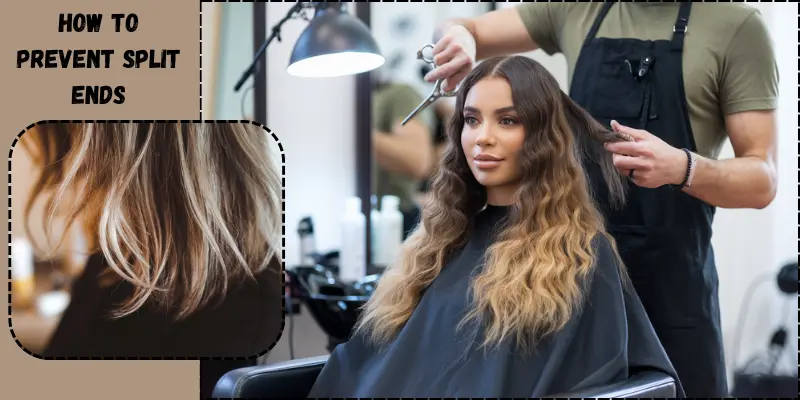How to Fix Split Ends Like a Hairstylist
Published: 29 Mar 2025
Imagine your hair is like a rope. When the ends get frayed and split into two or more parts, those are split ends. They make your hair look dry and unhealthy.
Split ends happen when your hair gets damaged. Too much heat from styling tools, rough brushing, or even not enough moisture can cause them. Even the sun and wind can make them worse!
The truth? Once a strand splits, you can’t fully repair it. But don’t worry – you can hide them temporarily or trim them for good.
In this guide, we’ll dive into how to fix split ends the right way. I’ll share simple, effective methods to prevent them, temporarily smooth them, and when needed, trim them properly. By the end, you’ll know exactly how to keep your hair looking healthy and split-end free! Let’s get started!
How to Prevent Split Ends

Split ends can make your hair look frizzy and unhealthy, but the good news? You can stop them before they start!
Here’s exactly how:
Trim Your Hair Regularly
Think of split ends like a loose thread on a sweater if you don’t cut it, it keeps unraveling. Getting a small trim every 6-8 weeks stops splits from traveling up your hair. Even if you’re growing your hair out, regular trims keep it looking fresh and healthy.
Use a Wide-Tooth Comb on Wet Hair
Wet hair is fragile and breaks easily! Instead of yanking a brush through tangled strands, use a wide-tooth comb starting from the ends and working up. This prevents unnecessary pulling that leads to splits.
Avoid Too Much Heat (Blow Dryers, Straighteners)
Heat tools fry your hair over time, making ends dry and brittle. If you must use them:
- Always apply heat protectant (like a spray or serum).
- Use the lowest heat setting that works for your hair.
- Try air-drying when you can—your hair will thank you!
Protect Hair from Sun & Chlorine
Sun and pool chemicals suck moisture from your hair, leaving it weak and prone to splitting.
- Wear a hat in strong sunlight.
- Rinse hair with fresh water before swimming (so it absorbs less chlorine).
- Use a leave-in conditioner for extra protection.
Small changes make a big difference! Start with one or two of these tips, and you’ll notice healthier ends in no time.
Best Ways to Treat Split Ends
Let’s be real – once you’ve got split ends, the only permanent fix is a haircut. But don’t worry! I’ve got some great ways to temporarily smooth and disguise them until your next trim. These treatments will make your hair look and feel healthier right away.
Deep Conditioning with Hair Masks & Oils
Your dry, splitting ends crave moisture, and that’s where these treatments shine. Natural oils like olaplex and argan work by penetrating the hair shaft to:
- Replace lost moisture
- Smooth frayed cuticles
- Add protective shine
For best results:
• Warm coconut oil between your palms before applying to ends
• Leave treatments on for at least 30 minutes (overnight for extra dry hair)
• Rinse with cool water to seal in benefits
Daily Protection with Leave-in Conditioners
Think of these as your hair’s daily armor against damage. A good leave-in will:
- Create a protective barrier
- Reduce future breakage
- Make styling easier
My pro tips:
→ Apply to towel-dried hair
→ Focus on mid-lengths to ends
→ Reapply between washes if needed
Instant Fixes with Serums & Menders
When you need quick results for a special occasion, these products:
- Temporarily “fuse” split ends together
- Add instant shine
- Tame flyaways
Remember:
• Less is more – start with a dime-sized amount
• Apply only to dry hair
• Avoid product buildup by washing thoroughly
The truth? No product can permanently repair split ends – but these solutions will absolutely help disguise them and prevent further damage. The key is using them consistently while maintaining regular trims.
When to Cut Split Ends
Let’s talk about the not-so-fun but necessary part of hair care – cutting those split ends. I know it hurts to see your hard-earned length go, but trust me, your hair will thank you later. Here’s how to know when and how much to trim.
Signs You Need a Trim (Don’t Ignore These!)
Your hair sends clear signals when it’s time for scissors. The most obvious signs include:
- Those little white dots at the ends of your strands (that’s where the splitting starts)
- Ends that feel rough and straw-like, no matter how much conditioner you use
- Increased tangling because split ends love to catch on each other
- Hair that won’t hold style because damaged ends won’t cooperate
If you’re seeing these warning signs regularly, it’s definitely trim time. Waiting too long just means you’ll need to cut off more later!
How Much to Cut: Dusting vs. Full Trim
Not all trims are created equal. Here’s what you need to know:
• Dusting (Micro-Trim):
- Removes just 1/8 to 1/4 inch
- Perfect for maintaining length while removing damage
- Should be done every 6-8 weeks
- Great for: Regular maintenance, hair growth journeys
• Full Trim:
- Takes off 1/2 inch or more
- Necessary when damage has traveled up the hair shaft
- Best for: Severely damaged ends, major fresh starts
- Frequency: Every 3-4 months, or as needed
Can You DIY?
Yes, With These Precautions:
While I always recommend professional cuts when possible, you can definitely maintain between salon visits if you’re careful.
Here’s how:
Essential Tools:
✓ Sharp hair-cutting scissors (never use craft or kitchen scissors!)
✓ Fine-tooth comb
✓ Good lighting
✓ Hair clips for sectioning
Step-by-Step:
- Start with clean, dry hair
- Take small sections (about 1-inch wide)
- Twist each section tightly – splits will stick out
- Carefully snip just the damaged bits that protrude
- Work your way around your head evenly
Pro Tips:
- Cut less than you think you need to at first
- Never cut when you’re rushed or distracted
- Consider having a friend help with the back sections
Remember: Regular small trims actually help you retain length in the long run by preventing damage from traveling up the hair shaft. It might seem counterintuitive, but cutting a little now means cutting less later!
FAQs
1. Can you actually repair split ends?
No, once a hair strand splits, it can’t be permanently repaired. Products can temporarily smooth and seal them, but trimming is the only real solution. Regular trims prevent splits from worsening.
2. How do you fix split ends without cutting?
You can temporarily improve their appearance with:
• Hydrating hair masks & oils
• Leave-in conditioners
• Split-end serums
These help but won’t eliminate splits completely.
3. How do you fix split ends naturally?
Try DIY treatments like:
- Coconut or argan oil masks
- Honey + yogurt hydrating mixes
- Cold water rinses to seal cuticles
Natural methods add moisture but won’t “heal” splits.
4. Can split ends be straightened?
Heat styling might smooth them temporarily, but it often worsens damage. Always use heat protectant, and opt for serums instead for safer results.
5. How often should I trim to prevent split ends?
Every 6-8 weeks for maintenance (dusting). If hair is very damaged, a ½-inch trim every 3 months helps. Regular care reduces future splits!
Conclusion
So guys, in this article, we’ve covered how to fix split ends in detail from prevention to temporary fixes and the inevitable trim. Personally, I swear by weekly coconut oil treatments and 8-week dusting trims they’ve saved my ends countless times!
Now it’s your turn: Pick one tip to try this week, whether it’s switching to a wide-tooth comb or testing a split-end serum. Your hair will thank you! Got questions? Drop them below. I’d love to help!

- Be Respectful
- Stay Relevant
- Stay Positive
- True Feedback
- Encourage Discussion
- Avoid Spamming
- No Fake News
- Don't Copy-Paste
- No Personal Attacks

- Be Respectful
- Stay Relevant
- Stay Positive
- True Feedback
- Encourage Discussion
- Avoid Spamming
- No Fake News
- Don't Copy-Paste
- No Personal Attacks






